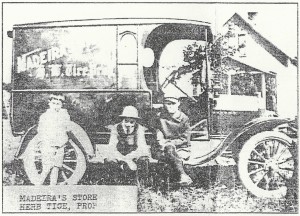By Regina Villiers. Originally published June 25, 1997 in The Suburban Life, added June 13, 2015.
Many of us remember with nostalgia Dot and Mack’s Grocery, which, until its demise, stood on the corner across from Adrien’s in the heart of Madeira.
But other stores stood there before Dot and Mack’s – Hemsath’s and a very early one, Tice’s.
For a long time, I’ve had a dim photo that I was able to copy from a faded photograph. The photo shows an ancient-looking delivery truck, and the lettering on the side says: “Madeira’s Store, H.W. Tice, Prop.”
I’ve tried to dig up the story of this picture, with little success. Obviously, few people are still around to remember it.
But recently, the story of this grocery just dropped into my pen, from a woman who has been a big help to me in writing stories of Madeira’s history.
Drucilla Bain, a retired teacher, is a member of one of Madeira’s historic families. Her grandfather, Samuel K. Druce was Madeira’s first mayor. Drucilla recently brought me some old newspapers her mother, Mary Lee Druce Bain, had stashed away. Drucilla thought I might find some stories in those yellowed pages.
And, of course, I did.
Throughout this century, Madeira has had small, local newspapers that published for a while and then passed on to small newspaper heaven. Some are remembered, while some left little trace of ever being here.
Among the newspapers Drucilla brought were copies of Madeira News, published in the years just before and after 1920. It was a small, newsletter-sized publication, with few pages and no photos. Mostly, it was church news and small items of local interest, with an occasional feature, which read more like an advertisement. There were no reporters’ names, and no editor or publisher was listed.
But one issue of Madeira News, dated Oct.21, 1927, I found a story that immediately caught my attention.
On the front page, alongside the Methodist Church news was a feature story that jumped to “last page,” which was the fourth page. The newspaper was just an 8.5- by- 11-inch fold over. The title of the piece: “Tice’s Ten Years In Madeira.”
According to the story, Tice’s had been in Madeira almost 11 years, which would put its origin back to 1916.
I have always thought Tice’s was on the location of Dot and Mack’s, but this story said Tice’s originally started in the Bean Grocery, which later became the Bauer Store, next to the little building that is now the shoe shop.
In 1916, according to the story, Madeira had three small grocery stores, and the Tice’s bought the “largest and best” of the three Bean’s.
After the first year, the business had grown so much that they needed more space, and they built a new store on the opposite corner. (The Dot and Mack’s location)
Shortly after that, according to the story, the Tice’s bought out the other two groceries in Madeira. The Riehl “s which was located at the southwest corner of Camargo and Miami owned one of these. The other was run by the Morrison’s, on the northeast corner of Camargo and Miami.
The Tice’s consolidated these two stores into one, in the Morrison building, and turned it into a meat market. The meat market was popular, the story said, for Madeira had not had a meat market for years.
Since the Tice’s now had a monopoly on the grocery business in Madeira, their stores flourished.
In their second year, the Tice’s put their business on a cash basis and started delivering, with a small fee. They insisted, of course, that this was merely to be able to give the customer “more attractive prices.”
Around 1925, the store had grown till they had to expand by building a large garage and warehouse, at a cost of $4,000. (What would that cost today?)
Tice’s was owned and operated by H.W. (Herb) Tice and his wife. A son, Winfield, was mentioned in the article, which said that Winfield, in California, would be back soon to teach his father “how they do it out there.”
Much of the article was devoted to listing a sample delivery order, which had been delivered that week.
The order, it said, was large and delivered in two sections on two days. About 50 items, enough to stock a kitchen, were listed, at a total cost of $34.19. The items and their prices will cause your breath to clot in your throat.
The list contained staples, fruits, vegetables, dairy products and meats. The fruits included a dozen each of all citrus fruits, and the dairy products included eggs and cream. Also included: luxury items like caviar, olives, wild rice, three pints of oysters, Guava jelly, and 10 squabs.
Thirty-five lamb chops cost $1.30, and “lean beef” cost 15 cents a pound. Thirty pounds of potatoes cost 70 cents, and some items, like spices, hardly seemed worth charging for. A box of pepper cost 10 cents, as did a box of sage. And a box of bay leaves cost only four cents.
But, the story said, no order was too small for the Tice’s.
“If you send your child in for a penny’s worth of candy or a cake of yeast,” it said, “he will receive the same treatment as if you came in yourself and bought $10 worth.”
Tice’s had the best of help, the story claimed. Mack Addison was in charge of meats and had been in the meat business for a long time. Ray Hull had been with Tice’s for about two years, at the time of the story.
Mrs. Cooper (no first name given) was a newcomer to the store, but was “well and favorably known in Madeira,” the story said.
So, thanks to the newspaper-hoarding of Drucilla Bain’s mother, I now have a story to go with my old photo.
